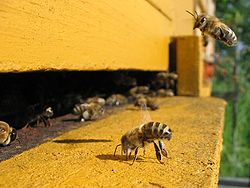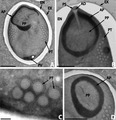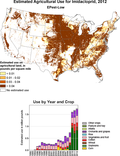Colony collapse disorder
Colony collapse disorder (CCD) is an occurrence where worker bees from a beehive abruptly disappear. The exact cause of colony collapse disorder is unknown. However, chemicals, parasites, and Varroa mites have been proposed as factors contributing to colony collapse disorder.[1]
Early in 2013, the European Food Safety Authority issued a declaration that three specific neonicotinoid pesticides pose an acute risk to honeybees, and the European Commission (EC) proposed a two-year ban on them.[2] David Goulson, who led one of the key 2012 studies at the University of Stirling said that the decision "begs the question of what was going on when these chemicals were first approved." The chemical manufacturer Bayer said it was "ready to work with" the EC and member states.[3]
Colony Collapse Disorder Media
A hyperparasitic microsporidian, Nosema podocotyloidis, a parasite of a digenean, Podocotyloides magnatestis, which is itself a parasite of the fish Parapristipoma octolineatum (Teleostei)
References
- ↑ "Colony Collapse Disorder: the search for the cause". Scientific American. 2011. Retrieved March 15, 2011.
- ↑ Warner, Bernhard (19 February 2013). To revive honey bees, Europe proposes a pesticide ban. http://www.businessweek.com/articles/2013-02-19/to-revive-honey-bees-europe-proposes-a-pesticide-ban. Retrieved 6 March 2013.
- ↑ Carrington, Damian (16 January 2013). Insecticide 'unacceptable' danger to bees, report finds. http://www.guardian.co.uk/environment/2013/jan/16/insecticide-unacceptable-danger-bees. Retrieved 9 March 2013.
+{{{1}}}−{{{2}}}









